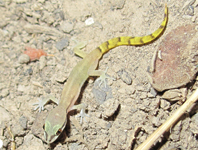Abstract
The frogs of the genus Pristimantis are recognized for their characteristic reproductive mode and for their incredible diversity of species, becoming the genus with the highest number of species within tetrapod vertebrates. We describe here a new species of Pristimantis from the northwestern Andes of Colombia. The species was found between 2000-2500 m.a.s.l., mostly within moss hanging of tree branches in a tropical cloud forest. It can be easily distinguished from other Pristimantis species of the western Andes by the unique black and white patterning in the ventral surface and the flanks, the hourglass-shaped dorsal folds, and the prominent conical tubercles on eyelids, heels, and outer edge of tarsus. A phylogenetic analysis further supports its status of a lineage reciprocally monophyletic to P. satagius and separated by a genetic distance of 0.03; the latter species bear whitish rather than predominantly black ventral coloration. To the best of our knowledge, this species is only known from the 2,500 ha nature reserve Mesenia-Paramillo, despite other research on this area of the country. Therefore, the species is declared vulnerable while new evidence on its distribution range is accumulated.
References
Álvarez, M.D. (2001) Could peace be worse than war for Colombia’s forests? The Environmentalist, 21, 305–315.
https://doi.org/10.1023/A:1012904318418
Amézquita, A., Márquez, R., Medina, R., Mejía-Vargas, D., Kahn, T.R., Suárez, G. & Mazariegos, L. (2013) A new species of Andean poison frog, Andinobates (Anura: Dendrobatidae), from the northwestern Andes of Colombia. Zootaxa, 3620, 163–178.
https://doi.org/10.11646/zootaxa.3620.1.8
Baptiste, B., Pinedo, M., Gutierrez, V.H., Andrade, G.I., Vieira, P., Estupiñán-Suárez, LM., & Lee, T.M. (2017) Greening peace in Colombia. Nature Ecology & Evolution, 1, 102.
https://doi.org/10.1038/s41559-017-0102
Duellman, W.E., Lehr, E. & Venegas, P.J. (2006) Two new species of Eleutherodactylus (Anura: Leptodactylidae) from the Andes of northern Peru. Zootaxa, 1285, 51–64.
Edgar, R.C. (2004) MUSCLE: multiple sequence alignment with high accuracy and high throughput. Nucleic Acids Research, 32, 1792–1797.
https://doi.org/10.1093/nar/gkh340
Frost, D.R. (2018) Amphibian Species of the World: an Online Reference. Version 6.0. American Museum of Natural History, New York, USA. Available from: http://research.amnh.org/herpetology/amphibia/index.html (accessed 9 may 2018)
García-R., J.C., Mendoza, A.M., Ospina, O., Cárdenas, H. & Castro, F. (2014) A morphometric and molecular approach to define three closely related species of frogs of the genus Pristimantis (Anura: Craugastoridae) from the Cordillera Occidental in Colombia. Journal of Herpetology, 48, 220–227.
https://doi.org/10.1670/12-091
Gilroy, J.J., Woodcock, P., Edwards, F.A., Wheeler, C., Baptiste, B.L., Uribe, C.A.M., Haugaasen, T. & Edwards, D.P. (2014) Cheap carbon and biodiversity co-benefits from forest regeneration at a hot spot of endemism. Nature Climate Change, 4, 503.
https://doi.org/10.1038/nclimate2200
Harris, D.L. (1984) The fragmented forest. The Chicago University Press, London.
Jenkins, C.N., Pimm, S.L. & Joppa, L.N. (2013) Global patterns of terrestrial vertebrate diversity and conservation. Proceedings of the National Academy of Sciences, 110, 1–10.
https://doi.org/10.1073/pnas.1302251110
Lynch, J.D. (1991) New diminutive Eleutherodactylus from the Cordillera Central of Colombia (Amphibia: Leptodactylidae). Journal of Herpetology, 25, 344–352.
https://doi.org/10.2307/1564595
Lynch, J.D. (1995) Three new species of Eleutherodactylus (Amphibia: Leptodactylidae) from the paramos of the Cordillera Occidental of Colombia. Journal of Herpetology, 29, 513–521.
https://doi.org/10.2307/1564734
Lynch, J.D. & Duellman, W.E. (1997) Frogs of the genus Eleutherodactylus (Leptodactylidae) in western Ecuador, systematics, ecology, and biogeography. University of Kansas Natural History Museum Special Publications, 23, 1–236.
https://doi.org/10.5962/bhl.title.7951.
Lynch, J.D. & Rueda-Almonacid, J.V. (1998) New frogs of the genus Eleutherodactylus from the eastern flank of the northern Cordillera Central of Colombia. Revista de la Academia Colombiana de Ciencias Exactas, Físicas y Naturales, 22, 561–570.
Lynch, J.D. (1998) New species of Eleutherodactylus from the Cordillera Occidental of western Colombia with synopsis of the distribution of the species in Western Colombia. Revista Der la Academia Colombiana de Ciencias Exactas, Físicas y Naturales, 22, 117–148.
Lynch, J.D. (1999a) Lista anotada y clave para las ranas (género Eleutherodactylus) chocoanas del Valle del Cauca, y apuntes sobre las especies de la Cordillera Occidental adyacente. Caldasia, 21, 184–202.
Lynch, J.D. (1999b) Ranas pequeñas, la geometría de evolución, y la especiación en los Andes colombianos. Revista de la Academia Colombiana de Ciencias Exactas, Físicas y Naturales, 23, 143–159.
Minh, B.Q., Nguyen, M.A.T. & von Haesler, A. (2013) Ultrafast approximation for phylogenetic bootstrap. Molecular Biology and Evolution, 30, 1188–1195.
https://doi.org/10.1093/molbev/mst024
Mittermeier, R.A. (2004) Hotspots Revisited: Earth’s Biologically Richest and most Endangered Terrestrial Ecoregions. CEMEX, Mexico City. 391 pp.
Myers, N., Mittermeier, R.A., Mittermeier, C.G., da Fonseca, G.A.B. & Kent, J. (2000) Biodiversity hotspots for conservation priorities. Nature, 403, 853–858.
https://doi.org/10.1038/35002501
Nguyen, L., Schmidt, H.A., von Haeseler, A. & Minh, B.Q. (2015) IQ-TREE: a fast and effective stochastic algorithm for estimating maximum likelihood phylogenies. Molecular Biology and Evolution, 32, 268–274.
https://doi.org/10.1093/molbev/msu300
Padial, J.M., Grant, T. & Frost, D.R. (2014) Molecular systematics of terraranas (Anura: Brachycephaloidea) with an assessment of the effects of alignment and optimality criteria. Zootaxa, 3825 (1), 1–132.
https://doi.org/10.11646/zootaxa.3825.1.1
Pimm, S.L., Jenkins, C.N., Abell, R., Brooks, T.M., Gittleman, J.L., Joppa, L.N., Raven, P.H., Roberts, C.M. & Sexton, J.O. (2014) The biodiversity of species and their rates of extinction, distribution, and protection. Science, 344, 1246752.
https://doi.org/10.1126/science.1246752
Puillandre, N., Lambert, A., Brouillet, S. & Achaz, G. (2012) ABGD, Automatic Barcode Gap Discovery for primary species delimitation. Molecular Ecology, 21, 1864–1877.
https://doi.org/10.1111/j.1365-294X.2011.05239.x
Reardon S. (2018) FARC and the forest: Peace is destroying Colombia’s jungle—and opening it to science. Nature, 558, 169–170.
https://doi.org/10.1038/d41586-018-05397-2
Wilson, E.O. (1988) The current state of biological diversity. In: Wilson, E.O. (Ed.), Biodiversity. National Academy Press, Washington, D.C., pp. 3–18.

